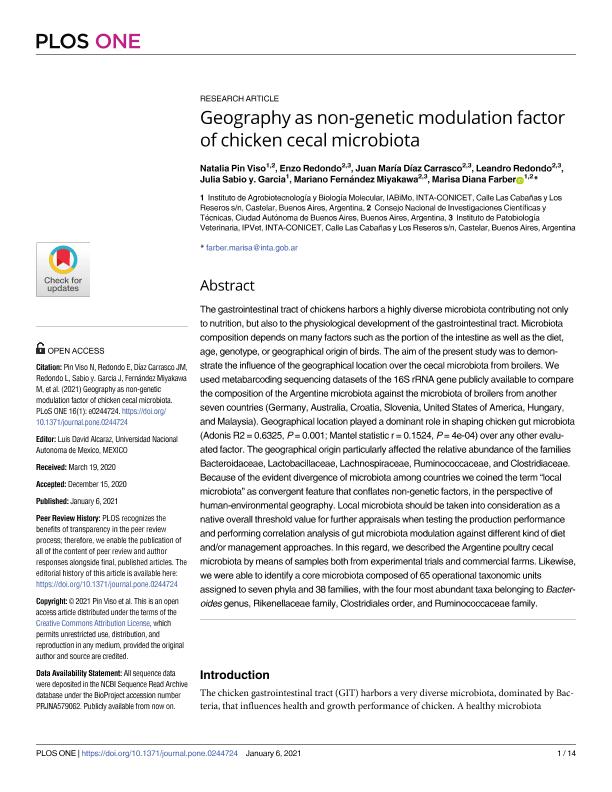Mostrar el registro sencillo del ítem
dc.contributor.author
Pin Viso, Natalia Daniela

dc.contributor.author
Redondo, Enzo Alejandro

dc.contributor.author
Díaz Carrasco, Juan María

dc.contributor.author
Redondo, Leandro Martin

dc.contributor.author
Sabio y Garcia, Julia Veronica

dc.contributor.author
Fernandez Miyakawa, Mariano Enrique

dc.contributor.author
Farber, Marisa Diana

dc.date.available
2023-01-12T12:17:49Z
dc.date.issued
2021-01
dc.identifier.citation
Pin Viso, Natalia Daniela; Redondo, Enzo Alejandro; Díaz Carrasco, Juan María; Redondo, Leandro Martin; Sabio y Garcia, Julia Veronica; et al.; Geography as non-genetic modulation factor of chicken cecal microbiota; Public Library of Science; Plos One; 16; 1; 1-2021; 1-14
dc.identifier.issn
1932-6203
dc.identifier.uri
http://hdl.handle.net/11336/184474
dc.description.abstract
The gastrointestinal tract of chickens harbors a highly diverse microbiota contributing not only to nutrition, but also to the physiological development of the gastrointestinal tract. Microbiota composition depends on many factors such as the portion of the intestine as well as the diet, age, genotype, or geographical origin of birds. The aim of the present study was to demonstrate the influence of the geographical location over the cecal microbiota from broilers. We used metabarcoding sequencing datasets of the 16S rRNA gene publicly available to compare the composition of the Argentine microbiota against the microbiota of broilers from another seven countries (Germany, Australia, Croatia, Slovenia, United States of America, Hungary, and Malaysia). Geographical location played a dominant role in shaping chicken gut microbiota (Adonis R2 = 0.6325, P = 0.001; Mantel statistic r = 0.1524, P = 4e-04) over any other evaluated factor. The geographical origin particularly affected the relative abundance of the families Bacteroidaceae, Lactobacillaceae, Lachnospiraceae, Ruminococcaceae, and Clostridiaceae. Because of the evident divergence of microbiota among countries we coined the term “local microbiota” as convergent feature that conflates non-genetic factors, in the perspective of human-environmental geography. Local microbiota should be taken into consideration as a native overall threshold value for further appraisals when testing the production performance and performing correlation analysis of gut microbiota modulation against different kind of diet and/or management approaches. In this regard, we described the Argentine poultry cecal microbiota by means of samples both from experimental trials and commercial farms. Likewise, we were able to identify a core microbiota composed of 65 operational taxonomic units assigned to seven phyla and 38 families, with the four most abundant taxa belonging to Bacteroides genus, Rikenellaceae family, Clostridiales order, and Ruminococcaceae family.
dc.format
application/pdf
dc.language.iso
eng
dc.publisher
Public Library of Science

dc.rights
info:eu-repo/semantics/openAccess
dc.rights.uri
https://creativecommons.org/licenses/by/2.5/ar/
dc.subject
GUT MICROBIOTA
dc.subject
POULTRY
dc.subject
GEOGRAPHICAL LOCATION
dc.subject.classification
Ganadería

dc.subject.classification
Producción Animal y Lechería

dc.subject.classification
CIENCIAS AGRÍCOLAS

dc.title
Geography as non-genetic modulation factor of chicken cecal microbiota
dc.type
info:eu-repo/semantics/article
dc.type
info:ar-repo/semantics/artículo
dc.type
info:eu-repo/semantics/publishedVersion
dc.date.updated
2022-03-09T17:58:35Z
dc.journal.volume
16
dc.journal.number
1
dc.journal.pagination
1-14
dc.journal.pais
Estados Unidos

dc.journal.ciudad
San Francisco
dc.description.fil
Fil: Pin Viso, Natalia Daniela. Instituto Nacional de Tecnología Agropecuaria. Centro de Investigación en Ciencias Veterinarias y Agronómicas. Instituto de Agrobiotecnología y Biología Molecular. Consejo Nacional de Investigaciones Científicas y Técnicas. Oficina de Coordinación Administrativa Parque Centenario. Instituto de Agrobiotecnología y Biología Molecular; Argentina
dc.description.fil
Fil: Redondo, Enzo Alejandro. Instituto Nacional de Tecnología Agropecuaria. Centro de Investigación En Ciencias Veterinarias y Agronómicas. Instituto de Patobiología Veterinaria.
Consejo Nacional de Investigaciones Científicas y Técnicas. Oficina de Coordinación Administrativa Parque Centenario. Instituto de Patobiología Veterinaria; Argentina
dc.description.fil
Fil: Díaz Carrasco, Juan María. Instituto Nacional de Tecnología Agropecuaria. Centro de Investigación En Ciencias Veterinarias y Agronómicas. Instituto de Patobiología Veterinaria.
Consejo Nacional de Investigaciones Científicas y Técnicas. Oficina de Coordinación Administrativa Parque Centenario. Instituto de Patobiología Veterinaria; Argentina
dc.description.fil
Fil: Redondo, Leandro Martin. Instituto Nacional de Tecnología Agropecuaria. Centro de Investigación En Ciencias Veterinarias y Agronómicas. Instituto de Patobiología Veterinaria.
Consejo Nacional de Investigaciones Científicas y Técnicas. Oficina de Coordinación Administrativa Parque Centenario. Instituto de Patobiología Veterinaria; Argentina
dc.description.fil
Fil: Sabio y Garcia, Julia Veronica. Instituto Nacional de Tecnología Agropecuaria. Centro de Investigación en Ciencias Veterinarias y Agronómicas. Instituto de Agrobiotecnología y Biología Molecular. Consejo Nacional de Investigaciones Científicas y Técnicas. Oficina de Coordinación Administrativa Parque Centenario. Instituto de Agrobiotecnología y Biología Molecular; Argentina
dc.description.fil
Fil: Fernandez Miyakawa, Mariano Enrique. Instituto Nacional de Tecnología Agropecuaria. Centro de Investigación En Ciencias Veterinarias y Agronómicas. Instituto de Patobiología Veterinaria.
Consejo Nacional de Investigaciones Científicas y Técnicas. Oficina de Coordinación Administrativa Parque Centenario. Instituto de Patobiología Veterinaria; Argentina
dc.description.fil
Fil: Farber, Marisa Diana. Instituto Nacional de Tecnología Agropecuaria. Centro de Investigación en Ciencias Veterinarias y Agronómicas. Instituto de Agrobiotecnología y Biología Molecular. Consejo Nacional de Investigaciones Científicas y Técnicas. Oficina de Coordinación Administrativa Parque Centenario. Instituto de Agrobiotecnología y Biología Molecular; Argentina
dc.journal.title
Plos One

dc.relation.alternativeid
info:eu-repo/semantics/altIdentifier/url/https://journals.plos.org/plosone/article?id=10.1371/journal.pone.0244724
dc.relation.alternativeid
info:eu-repo/semantics/altIdentifier/doi/https://doi.org/10.1371/journal.pone.0244724
Archivos asociados
